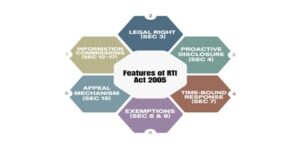Ethics Theory, TLP-UPSC Mains Answer Writing
Q. 2. “While the RTI Act has empowered citizens, its misuse and bureaucratic resistance have diluted its effectiveness.” Evaluate this statement with recent examples and suggest reforms. (150 words, 10 marks)
Introduction
The Right to Information (RTI) Act, 2005 is a cornerstone of participatory democracy, enabling transparency and accountability. However, bureaucratic pushbacks and increasing misuse threaten to weaken its transformative potential in governance.
Body
Key Features of the RTI Act:

Salient features of RTI Act 2005
- Statutory Right: Guarantees all citizens the right to information.(Section 03)
- Time-bound Disclosure: Information must be provided within 30 days(48 hours in life or liberty cases).
- Covers All Public Authorities: Includes central, state governments, and institutions substantially financed by public funds.
- Provision of Appeals: Includes a two-tiered appeals mechanism, ending at the Information Commission.
- Suo Motu Disclosure (Section 4): Mandates public authorities to voluntarily disclose key information.
- Penalties for Non-compliance: PIOs can be fined ₹250 per day for delays or refusal to provide information.
RTI as a Tool of Empowerment
The RTI Act has democratized access to public records, enabling citizens to question authority and demand accountability.
- Accountability in Governance: Information obtained through RTI has exposed scams like Adarsh Housing and irregularities in PDS, resulting in corrective actions.
- Empowerment of the Marginalized: Grassroots activists have used RTI to secure pensions, housing rights, and employment dues.
- Strengthening Democratic Participation: Citizens increasingly use RTI to engage with local institutions, holding them answerable.
Challenges Diluting RTI’s Effectiveness
Despite its potential, several systemic and behavioural issues have eroded the RTI Act’s impact.
- Bureaucratic Resistance: Many departments delay or deny information under vague exemptions.
Example: CIC recently pulled up the PMO and Defence Ministry for non-compliance with proactive disclosures. - Misuse of RTI: Frivolous or repeated applications overload the system and harass officials.
Example: An applicant in Maharashtra filed over 1,800 RTIs to settle personal scores with local authorities. - Weakening of Information Commissions: Lack of appointments, inadequate staffing, and delayed hearings hinder effective redressal.
Example: Several State Information Commissions like Bihar and Jharkhand have huge case backlogs with few commissioners. - Lack of Protection for RTI Activists: Threats, attacks, and even murders of RTI users deter genuine inquiries.
Example: Over 100 RTI activists have reportedly been assaulted or killed since 2005. - Recent Legal Changes: Amendments in 2019 reduced the autonomy of Information Commissioners by altering their tenure and salaries.
Reforms for Reviving RTI Effectiveness
- Strengthen Institutional Capacity: Appoint commissioners promptly, digitize records, improve infrastructure, and increase funding to reduce pendency, as also suggested by the 2nd ARC.
- Curb Misuse Mechanisms: Introduce filters for repetitive and vexatious queries without diluting citizens’ right to seek information.
- Protect Whistleblowers: Link RTI with robust protection under the Whistleblowers Protection Act to ensure safety of information seekers.
- Improve Awareness and Training: Conduct workshops for citizens and bureaucrats to improve quality of queries and responses.
- Promote Suo Motu Disclosure: Enforce Section 4 obligations for proactive disclosure as recommended by the 2nd ARC to minimize the need for applications.
Conclusion
RTI is a lifeline of transparency, but without reforms and administrative will, its spirit may fade. As Justice Brandeis said, “Sunlight is the best disinfectant”—transparency must remain central to public governance.














